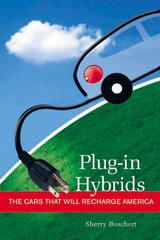I write a monthly column for the Electric Auto Association newsletter, Current EVents. Here's my April column.
As March came to a close, the Obama administration found GM and Chrysler’s restructuring plans “not viable.” GM CEO Rick Waggoner was pushed out and the company got sixty days to get its act together. Chrysler was told to consummate with Fiat quickly or else. At the same time, the value to the economy and environment of a major push for plug-in cars as part of the recovery hasn’t sunk in at the top. Obama should take extraordinary steps to empower the electric upstarts to prove their mettle. A billion dollars of loans and grants directly supporting Tesla, Th!nk, Fisker and Aptera, for example, would get cars on the road and allow the plug-in project the chance to more quickly advance to economic viability without the legacy burdens carried by the majors. And these days a billion dollars is barely a rounding error in the money going to prop up the American auto industry.
While the American government is deep in the morass of Detroit’s legacy, the Chinese leadership may have turned to face the future. As reported in the NY Times, “Chinese leaders have adopted a plan aimed at turning the country into one of the leading producers of hybrid and all-electric vehicles within three years, and making it the world leader in electric cars and buses after that.” BYD already has a plug-in hybrid for sale in small numbers in China, and has Warren Buffet-infused plans to market PHEVs and EVs in the US within a few years. Tianjin-Qingyan Electric is poised to offer an all-electric car in China before the end of the year for less than $30,000, before any incentives. Given the much lower production costs in China, the first Chinese company to pass American certification could place an EV on the market in the US that would cost a consumer under $20,000 (after incentives.) That would be a game changer.
Can I charge my new EV here?
At the moment only Tesla is putting cars on the road, at the rate of about 20 per week. But other cars, including the MINI E, will be out and about soon, and stimulus money abounds, so the question of public EV infrastructure is much discussed. The EAA is taking the lead, along with Plug In America, to get it done right. A major error of the ZEV mandate period, no single connector standard, will be overcome once the SAE Standards Committee finally approves the new protocols. That process has been too slow, already resulting in new cars with differing connectors on the road.
A new opportunity and complication has appeared with startup companies appearing that wish to offer competing subscription-based public charging networks. The EAA and Plug In America are working closely with these companies to ensure adherence to some basic principles: universal access, interoperability and maintaining needed legacy infrastructure. In the future, any plug-in car must be able to charge at any public charger.
New public charging infrastructure, however, won’t bring us electric cars. And while I can testify that it is useful to have public access chargers, people with RAV4 EVs in places like Long Island, Hawaii, and Nova Scotia have gotten along fine without. The effort to get cars to market must remain our focus. Stop in at a car dealer today and let them know: No Plug? No Deal!
Friday, April 24, 2009
Subscribe to:
Post Comments (Atom)



2 comments:
Is Current EVents available to the public? Is it on the web? Thanks!
Current EVents is mailed to members of the Electric Auto Association. You can join at http://www.electricauto.org. Past issues are archived at the same website.
Post a Comment